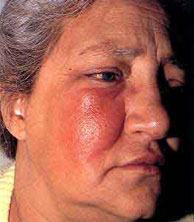Erysipelas infection - treatment

Erysipelas is a streptococcal INFECTION of the dermis, the middle layer of the SKIN. Infection commonly follows STREP THROAT, with the BACTERIA likely carried on the hands to the skin where a scratch or other breach allows the bacteria to colonize into an infection. The infection presents characteristic symptoms that allow prompt clinical diagnosis. These symptoms include
- redness (erythema), swelling (edema), and PAIN at the site of the infection
- clearly defined and usually raised border between the infection and healthy skin
- swelling of adjacent LYMPH NODES
- FEVER, generalized discomfort, and aching in the muscles and joints
Erysipelas infection Treatment
Treatment is a course of ANTIBIOTIC MEDICATIONS, preferably penicillin unless the person is allergic, and medications to relieve pain and fever. Warm compresses help bring blood to the area, improving the effectiveness of the body’s IMMUNE RESPONSE to attack the infection and increasing circulation of the antibiotic.
It is important for people to take ANTIBIOTIC MEDICATIONS prescribed to treat erysipelas as the doctor directs, and to use them until all the antibiotic is gone, to completely eradicate the streptococcal BACTERIA.
Prompt medical attention is essential as erysipelas can rapidly invade deeper tissues, causing CELLULITIS and perhaps SEPTICEMIA (bodywide infection). Untreated or undertreated streptococcal infections also present the risk for INFLAMMATION of the HEART valves (RHEUMATIC HEART DISEASE). With treatment, symptoms improve within 72 hours and the erysipelas resolves completely in 10 to 14 days. People who have DIABETES, impaired peripheral circulation, and IMMUNE DISORDERS are at increased risk for erysipelas. Preventive measures include HAND WASHING after coughing or sneezing.
See also SCARLET FEVER.